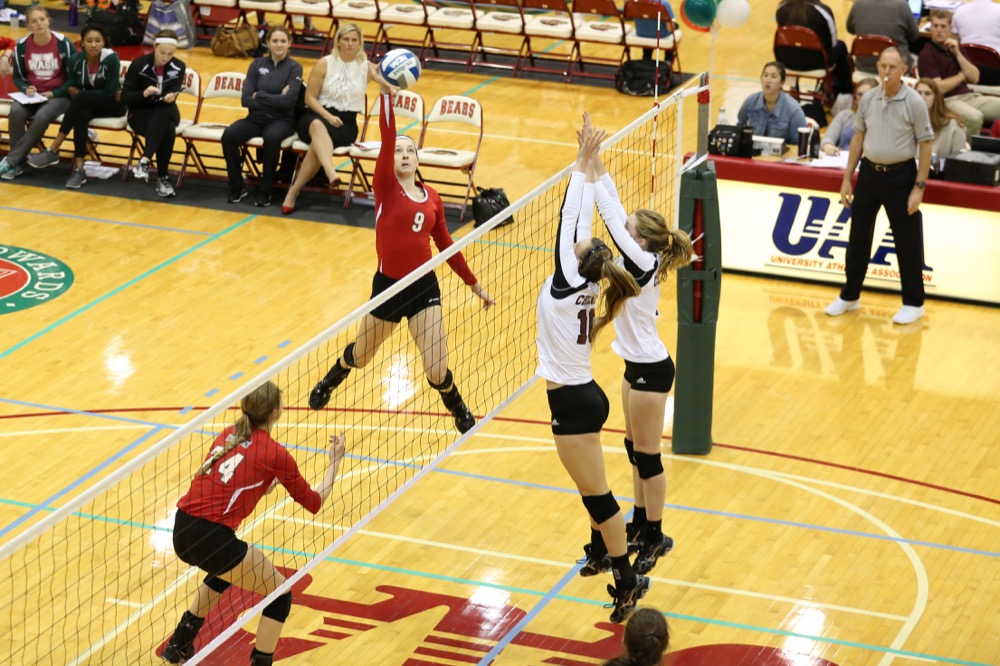It’s been six years since the Washington University volleyball team last made it to the NCAA tournament’s final weekend. Six years, 161 wins, 7,227 kills and five unsuccessful postseason runs; all in search of an 11th championship banner to hang from the Field House rafters. Maybe calling this a drought is debatable, but six seasons out of the limelight for arguably the most successful collegiate volleyball program ever is enough to raise a few eyebrows. But they’re back now, headed to Oshkosh, Wis.—where they won the national championship 20 years ago—three games away from collegiate sports immortality.
Clik here to view.
 Skyler Kessler | Student Life
Skyler Kessler | Student LifeTo earn it, they’ll have to get past No. 14 the University of Mary Washington tonight in the tournament quarterfinals. If they win, it’ll be either No. 7 Southwestern University or Tufts University in the final four the next day. The smart money is on Southwestern. The Pirates are this year’s survivor of the group of death, the annual collection of top-10 volleyball programs that are restricted to a west coast regional due to travel constraints. The Bears were in that draw last year when they lost in the regional final to the California Lutheran University, the eventual national champion.
After that, the bracket is much more of a toss up. If the Bears make it to the finals, they could be up against any one of No. 2 Calvin College, No. 5 Emory University, No. 18 University of Northwestern—St. Paul or No. 13 Eastern University. Calvin and Emory clock in as the two favorites from that side of the bracket, but the Knights and Eagles will have to duke it out against each other in the quarterfinals, before setting their sights on the rest of the field.
The odds are tough for a Bears team that has struggled all season to consistently assert itself at the national level. But whether it was grit, coaching, luck or talent that vaulted them into this position, the chance to stamp their names on the NCAA history books seems like a birthright for athletes in the Wash. U. volleyball program.
Here’s an idea of what to expect.
How did they get here?
It’s only because of the essentially uninterrupted three decades of success that the shortcomings of this year’s Wash. U. team are even notable. At 25-10, the Bears still have a .714 winning percentage, but this is the first time since 1985 that the Bears have double-digit losses. Even if they take home the national trophy, this will only be the second year since 1985 that Wash. U. failed to eclipse 30 wins. Especially early in the season, the Bears struggled to keep their footing, dropping winnable games and getting blown out by teams they handled smoothly a year ago.
But this all sounds like a broken record. The real story of this year’s Bears is not in figuring out how they’re as good as their predecessors but seeing how they’ve evolved over the course of just this one season.
The Bears benefited from a manageable draw this year, but to move on to Oshkosh, they still had to upset No. 11 University of Wisconsin-Whitewater. The Red and Green did, defeating the Warhawks 24-26, 25-16, 25-21, 25-20. During that game, Wash. U. hit a scalding 0.366 as a team. Compare that to the 0.066 the Bears hit during their first game against Whitewater this year, and you can already see the difference. Through the Bears’ first 10 games of the season, a span where the Red and Green went 5-5, they hit a collective 0.211. Since then, they are 20-5 and hitting 0.251. Shorten that to the last six games, and the numbers are 5-1 and 0.296. They’re getting better—and just in time for Mary Washington.
Washington squared
Despite what Mary Washington’s daunting 31-3 record may suggest, the Eagles and Wash. U. are more alike than you may think. Both teams are tightly matched in hitting percentage (0.241 for Mary Wash. and 0.240 for Wash. U.), kills per set (13.14 to 13.17) and opponents hitting percentage (0.157 to 0.144). Both teams employ a diverse offense, with four players from each team averaging above two kills per set and a defense by committee.
Where the two teams do diverge is playing experience. The Bears have already played 12 games against ranked opponents this season, with seven of them coming against top-10 opponents. Meanwhile, the Eagles have played just seven ranked games in total. In the three games the Eagles do have against top-10 opponents, they’ve hit a paltry 0.110. Compare that to the 0.218 that the Bears hit against the same category of opponents, and you can see that the Bears have had slightly more success at the national stage. Even in their four-set victory over No. 10 Juniata College that propelled Mary Wash. into the elite eight, the Eagles were still outhit by Juniata and only skirted by thanks in part to 15 service errors from their opponents.
How Mary Wash. is able to cope against a nationally competitive program like the Bears may go a long way in deciding the outcome of this quarterfinal matchup.